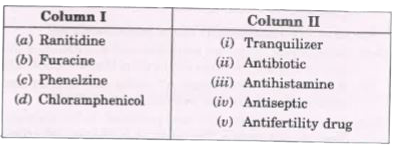If soap has high alkali content it irritates skin. How can the amount of excess alkali be determined ? What can be the source of excess alkali ?
Step-by-Step Solution:
1. Understanding the Problem:
- The question states that soap with high alkali content can irritate the skin. We need to determine how to measure the excess alkali and identify its source.
2. Determining Excess Alkali:
- To quantify the excess alkali in soap, we can use acid-base titration. This method allows us to measure the amount of alkali present in the soap solution by neutralizing it with a standard acid.
3. Preparing the Soap Solution:
- First, prepare a soap solution by dissolving a known amount of soap in distilled water. This will create a solution that contains the alkali present in the soap.
4. Choosing the Titrant:
- For the titration, we can use hydrochloric acid (HCl) as the titrant. It is a strong acid with a known concentration (normality), which will react with the alkali in the soap.
5. Using an Indicator:
- To determine the endpoint of the titration, we will use phenolphthalein as an indicator. Phenolphthalein changes color from pink (basic solution) to colorless (neutral or acidic solution) when the alkali is neutralized.
6. Conducting the Titration:
- Slowly add the HCl solution to the soap solution while continuously stirring. Monitor the color change of the solution. Once the pink color disappears, it indicates that all the excess alkali has been neutralized.
7. Calculating the Amount of Excess Alkali:
- Record the volume of HCl used to reach the endpoint. Using the known concentration of HCl and the volume used, you can calculate the amount of excess alkali present in the soap using the stoichiometry of the neutralization reaction.
8. Identifying the Source of Excess Alkali:
- The source of excess alkali in soap is typically due to incomplete hydrolysis of oils or fats during the soap-making process. If the oils are not fully saponified, some alkali remains unreacted, leading to higher alkali content in the final product.
- The question states that soap with high alkali content can irritate the skin. We need to determine how to measure the excess alkali and identify its source.
- To quantify the excess alkali in soap, we can use acid-base titration. This method allows us to measure the amount of alkali present in the soap solution by neutralizing it with a standard acid.
- First, prepare a soap solution by dissolving a known amount of soap in distilled water. This will create a solution that contains the alkali present in the soap.
- For the titration, we can use hydrochloric acid (HCl) as the titrant. It is a strong acid with a known concentration (normality), which will react with the alkali in the soap.
- To determine the endpoint of the titration, we will use phenolphthalein as an indicator. Phenolphthalein changes color from pink (basic solution) to colorless (neutral or acidic solution) when the alkali is neutralized.
- Slowly add the HCl solution to the soap solution while continuously stirring. Monitor the color change of the solution. Once the pink color disappears, it indicates that all the excess alkali has been neutralized.
- Record the volume of HCl used to reach the endpoint. Using the known concentration of HCl and the volume used, you can calculate the amount of excess alkali present in the soap using the stoichiometry of the neutralization reaction.
- The source of excess alkali in soap is typically due to incomplete hydrolysis of oils or fats during the soap-making process. If the oils are not fully saponified, some alkali remains unreacted, leading to higher alkali content in the final product.
Topper's Solved these Questions
- CHEMISTRY IN EVERYDAY LIFE BOOK - MODERN PUBLICATIONCHAPTER - CHEMISTRY IN EVERYDAY LIFE EXERCISE - NCERT (MATCHING TYPE QUESTIONS )
6 Videos
- CHEMISTRY IN EVERYDAY LIFE BOOK - MODERN PUBLICATIONCHAPTER - CHEMISTRY IN EVERYDAY LIFE EXERCISE - NCERT (ASSERTION AND REASON TYPE QUESTIONS)
14 Videos
- CHEMISTRY IN EVERYDAY LIFE BOOK - MODERN PUBLICATIONCHAPTER - CHEMISTRY IN EVERYDAY LIFE EXERCISE - NCERT (MULTIPLE CHOICE QUESTION (TYPE-II))
12 Videos
- BIOMOLECULESBOOK - MODERN PUBLICATIONCHAPTER - BIOMOLECULESEXERCISE - UNIT PRACTICE TEST FOR BOARD EXAMINATION
13 Videos
- D AND F-BLOCK ELEMENTSBOOK - MODERN PUBLICATIONCHAPTER - D AND F-BLOCK ELEMENTSEXERCISE - UNIT PRACTICE TEST
12 Videos
Similar Questions
Match the mediccne given in Column I with their use given in Column II .

View SolutionAssertion (A) Penicillin (G) is an antihistamine.
Reason (R) Penicillin (G) is effective against gram positive as well as gram negative bacteria.
View SolutionWhich of the following statements are incorrect about receptor proteins?
View SolutionGlycosidic linkage is :
View SolutionIn alkaline medium, KMnO4 oxidises iodide ion to
View SolutionIf soap has high alkal content it irritates skin. How can amount of excess alkali be determind? What can be the source of excess alkali ?
View SolutionWashing soap can be prepared by saponification with alkali of the oil
View SolutionHow alkali metal halides can be prepared?
View SolutionIf soap has high alkali content it irritates skin. How can the amount of excess alkali be determined ? What can be the source of excess alkali ?
View SolutionIf soap has high alkali content it irritates skin. How can the amount of excess alkali be determined? What can be the source of excess alkali?
View SolutionWashing soap can be prepared by saponification with alkali of which of the following oil
View SolutionIf soap has high alkali content it irritates skin. How can the amount of excess alkali be determined ? What can be the source of excess alkali?
View SolutionIf soap has high alkal content it irritates skin. How can amount of excess alkali be determind? What can be the source of excess alkali ?
View SolutionBy which method, concentration of alkali metal can be determine ?
View SolutionOn dissolving Aluminum hydroxide in excess of alkali produces ...... ions.
View Solution

